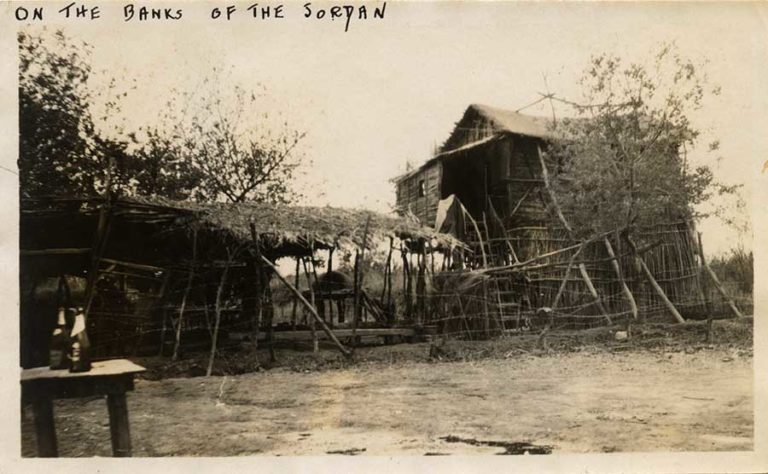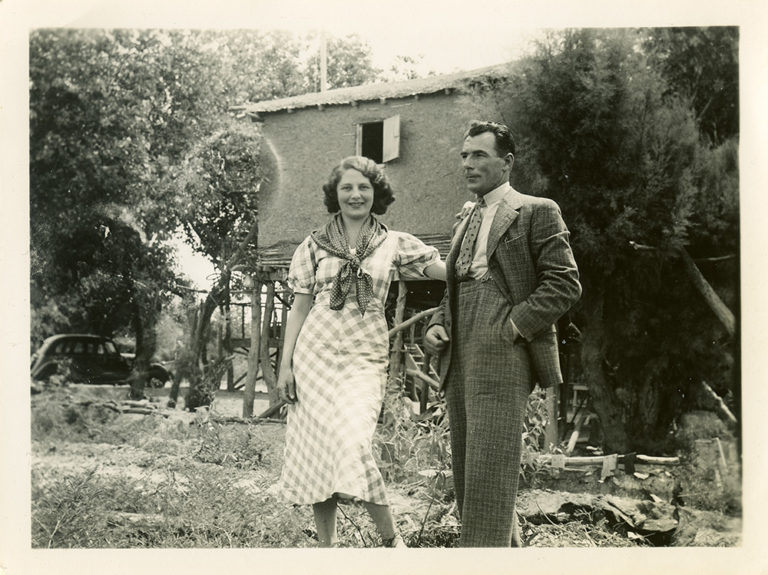
The mystery shack of Mr. Stomation near the Baptism site on the Jordan River photographed in 1924. Norbert Schiller Collection
I recently read In the Steps of the Master (1936), one of travel writer H.V. Morton’s books on the Holy Land. In the passage where he describes his visit to the baptism site on the Jordan River, Morton mentions a strange wooden shack built up on stilts alongside the riverbank.
When Morton spotted the structure, he wandered around the property trying to determine the purpose for the shack. The writer then discovered an inscription above the bar revealing the proprietor as “Mr. N. Stomation” whom he finds sitting in a chair, completely oblivious to Morton’s presence on his property. Morton’s description of his discovery is detailed in his book as follows:
“I was not prepared for the strange sight at the end of the road. On the river bank is an old café, or rest-house, mounted on stilts. The roof is made of Jordan reeds, and everything about it suggests that at any moment the narrow, inoffensive river might overflow and drive the few inhabitants to their boats. Under this frail shelter are set a number of home-made tables and chairs. Hens, chickens and turkeys and goats roam carelessly around the tables. A stuffed crane and a stuffed flamingo, both much the worse for wear, hang with dreary reluctance from the roof. There is a kind of counter, or bar, with a license which states that this collection of poles and reeds is owned by a Mr. N. Stomation. I discovered that the only visible inhabitant was someone, whom I took to be Mr. Stomation, sitting with his back to the Jordan gloomily whittling a stick with a pen-knife. He was in shirt sleeves, with an ancient khaki tunic flung across his shoulders. He paid no attention to me as I prowled about his strange retreat. The Jordan is apparently always trying to dislodge Mr. Stomation. His dwelling quarters, and also a large dome-shaped oven, are mounted on twelve-foot high stilts. Even the chickens, and the turkeys and the goats must sometimes be forced to run for it, as little pile dwellings to the side of the main quarters testify.”
I didn’t think anything about this passage until I began researching photos to illustrate the story on The Nativity Trail between Nazareth and Bethlehem which is posted on this website. While rummaging through my archives, I came across a photo, which showed a strange looking structure on stilts with water flowing in the foreground. A handwritten note on the picture describes its subject as follows: “On the Banks of the Jordan.” Suddenly I made the connection between Morton’s words and this image. The date on the photo indicates that it was taken in 1924, nearly a decade before Morton visited the site.
Upon further online research, I discovered a short black and white film taken in the 1920s showing a clip of the same shack on stilts. However, since there is no narration, it’s impossible to know why the structure was filmed. The clip was
most probably part of a larger production by a British crew making a promotional film about Palestine. Many such films were made at the time to highlight British “achievements” in Palestine after World War I.
Update:

A couple stands beside the shack on stilts belonging to Mr. Stomation, in April 1936, a few years after it was visited by the author H.V. Morton. Norbert Schiller Collection
I have since found another photo of the mystery shack taken in 1936, a few years after the author H.V. Morton visited the site and a decade after the original photograph I feature at the top was taken. What’s interesting about the newer photograph is that the exterior of the shack, which was originally made of wood branches and reeds, has been covered over with some sort of clay to give it a more permanent look. I am still interested to know the history of this shack and how long it remained on the banks of the Jordan river. If anyone has further information about the shack, or the proprietor, Mr. N. Stomation, I would be very interested in sharing it on this website.

Fascinating, Norbert.